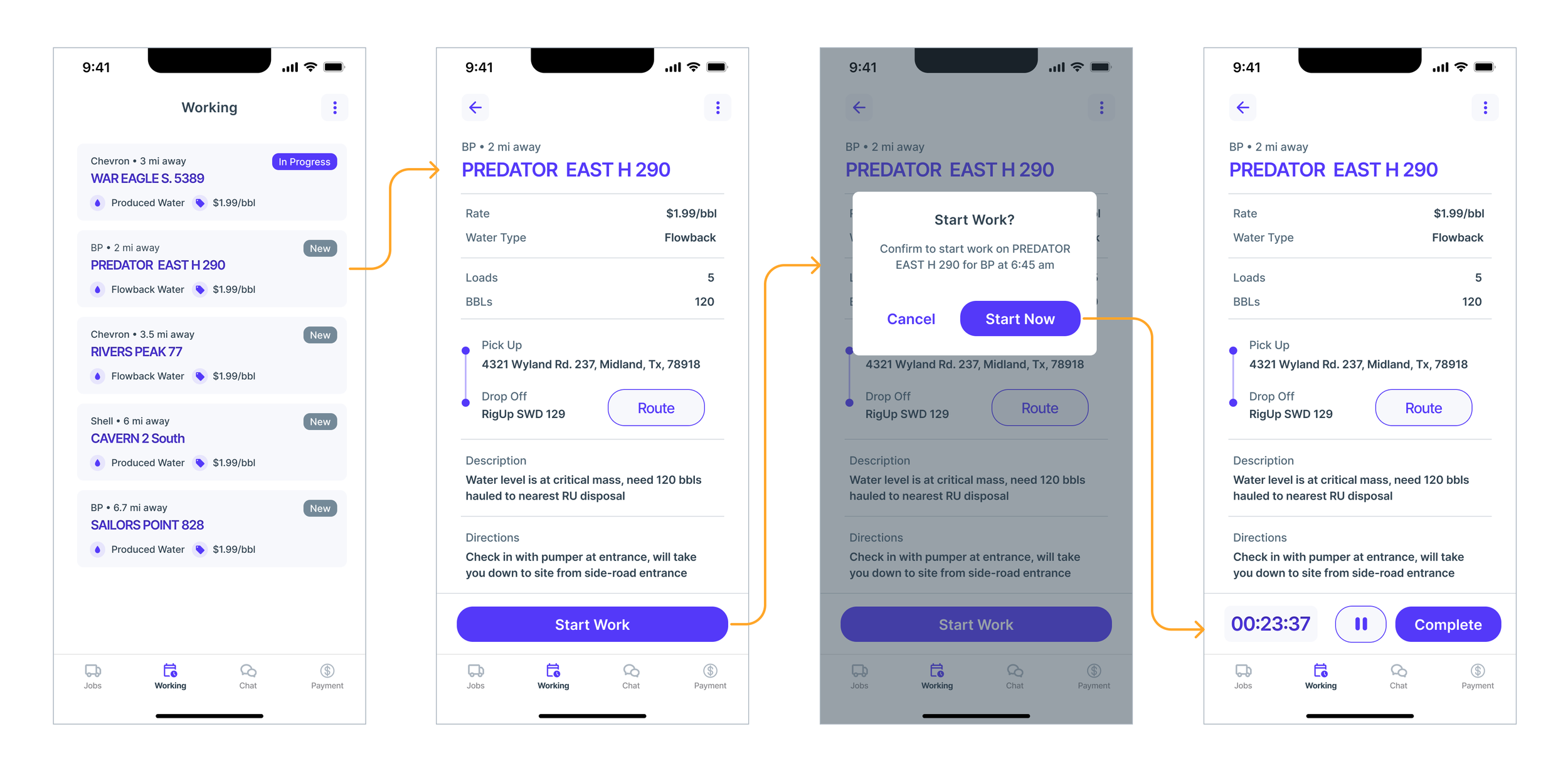About Workrise
Workrise, formerly known as RigUp is a B2B SaaS startup that enables energy companies to source labor from a vast network of qualified workers.
The Problem
Water hauling is essential for oil and gas companies, often requiring urgent, same-day services. However, sourcing drivers on demand is challenging, as traditional staffing firms lack the infrastructure to meet this need.
The Solution
A mobile application suite that integrates job searching, driver navigation, location tracking, and payment processing. Users can accept jobs and receive timely payments, while employers enjoy cost savings and automated payments, reducing expenses compared to traditional staffing firms.
Role: Lead Designer | Timeline: 8 weeks to MVP | Team: COO, 1 Designer, 4-6 Developers
Impact
The application transported over 1 million barrels of water within six months of launch, generating approximately $5 million in revenue and became the companies most profitable product within a year. It gained significant adoption from major clients like BP, Shell, and Exxon, with users rating the app highly, averaging 4.7 out of 5 in the app store.
Process and Learnings
The energy industry relies on timely fieldwork, but placing contractors is often a manual and frustrating process. On-site verification and lengthy invoicing can turn small jobs into months of calls and paperwork.
To address these challenges, we developed a field service app that swiftly staffs on-demand labor, reduces operational burdens, simplifies invoicing, and facilitates rapid scaling. Identifying the growing need for digitization in the water transfer industry laid the groundwork for our process.
RigUp Design Process
Research and Discovery
Our research efforts were essential to the design's success. The main challenge was understanding the existing system for employing and dispatching drivers before digitizing it, compounded by the evolving work environment, unexpected field obstacles, resistance to change, and disruption of long-standing manual practices.
Methods: User interviews & surveys, SME interviews, Field Studies, Analytics review, Focus groups, Moderated user testing
Deliverables: Behavioral archetypes, user journey maps, user flows, IA diagrams
Understanding The Driver’s Journey
Understanding our drivers' journey was crucial in creating a system that meets their needs. I categorized their journey into four main stages: planning and preparing for the day, picking up loads, disposal, and completing the workday.
Meet The Drivers
Drivers are often tech novices eager to secure higher-paying gigs to enhance their skills and earnings while minimizing idle time. They seek improved tools and support, aspire to grow their businesses, and place a high value on efficient work completion.
User Needs | Drivers
Meet The Dispatchers
Dispatchers, who are moderately tech-savvy, work for hauling companies and are responsible for sourcing, managing, scheduling, and paying drivers. They seek to increase revenue by securing more work for their drivers, desire a streamlined digital workflow, and value flexibility within the experience.
User Needs | Dispatchers
Brainstorming Workshops
Throughout the project, I facilitated collaborative workshops with stakeholders, subject matter experts, developers, and users.
They served as a platform for aligning perspectives and establishing a shared vision and strategy for the solution at hand.
Challenge | Conflicting Needs & Use Cases
Our research and workshops revealed we needed to accommodate for two differing critical use cases. Through in-depth analysis, it became clear that account personalization was essential in order to successfully cater to the needs of all our users.
Employer — Owner Operator Driver
Owner operators are independent drivers who do not work for an agency. They require access to all application features and manage their own schedules.
Employer — Dispatcher — 1099 Driver
Dispatchers manage or own agencies that employ drivers as contractors. They require control over job acceptance and driver assignments, while drivers need their own interface to fulfill work assignments.
Defining the User Flow
After defining user needs and the core features of the application, I mapped user flows and created application architecture diagrams. These served as alignment tools with stakeholders, ensuring our solution was feasible, viable, and user-friendly.
Wireframes & Testing
I created a mid-fidelity prototype for early user testing. I conducted user testing with 3 drivers and 3 dispatchers.
Additional requirements were documented and further iterations were produced.
High-Fidelity Solutions | Owner Operators

Owner operators can access nearby on-demand job listings, review key details, confirm their qualifications, and accept assignments directly.

Accepted jobs appear in the working tab, allowing users to clock in and track their hours. Satellite-based navigation provides routing even in no-service zones and directions to unmapped work sites. Location data is sent directly to the employer's dashboard.

After completing a job, drivers upload documents for verification and receive next-day payment, removing the need to manage multiple receipts and paperwork for various jobs throughout the week.
High-Fidelity Solutions | Dispatchers

Dispatchers can access job listings, review driver suitability, and assign drivers efficiently, all within a personalized interface that supports their schedules and operational control.

Once a job is accepted, dispatchers assign drivers, track progress in real-time, and can adjust assignments as needed. They also access real-time driver data to ensure compliance.
High-Fidelity Solutions | 1099 Contract Drivers

Drivers receive a daily SMS link for app access, bypassing account setup. They can view assignments and use features like satellite navigation, an intuitive interface, and a clock-in system to log hours.

Once the work is completed, drivers upload documents for job verification and next-day payment, eliminating the need for dispatchers to gather and submit paper documents weekly. This streamlines the process, reduces errors, and ensures timely payment.
Measuring Success
The application transported over 1 million barrels of water within six months of launch, generating approximately $5 million in revenue and became the companies most profitable product within a year. It gained significant adoption from major clients like BP, Shell, and Exxon, with users rating the app highly, averaging 4.7 out of 5 in the app store.












